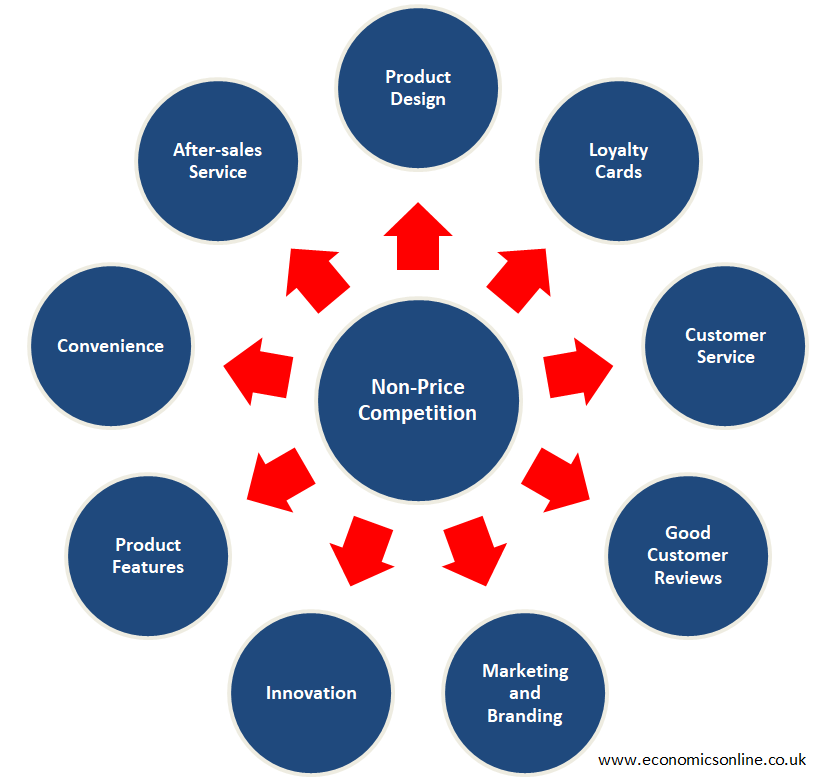
Non-Price Competition
What is Non-Price Competition?
Non-price competition refers to the methods used by firms to attract customers and increase sales other than a change in the price of the product. These methods may include product quality, design, innovation, a unique selling point, customer service, and so on.
In other words, non-price competition means competition among firms that is not based on changes in the price of a product. Instead, firms compete on factors other than price.
The importance of Non-Price Competition
In economics, competition is considered the cornerstone of economic efficiency. Traditionally, the model of perfect competition suggests that it is driven by price alone, with firms competing on the basis of who can offer the lowest price to consumers. This may be true for a homogeneous product like tomatoes, where consumers may want to go for the lowest price. However, in real life, markets deviate from perfect competition, and price becomes only one factor affecting the purchase decisions of customers. For example, if a customer wants to buy a smartphone, he/she may not go for the cheapest one unless restricted by a low budget. Other factors like design, features, branding, and quality may become more important than just price.
In real life, markets are imperfect and non-price competition can be very important in these markets especially when consumers are less sensitive to price changes, or where prices are already low due to intense price competition.
Non-Price Competition in Imperfect Competition
In real life, many markets fall into the category of oligopoly, where there are a few dominant sellers. In oligopoly, firms can compete on the basis of price, yet in a non-collusive model, the kinked demand curve theory suggests that price is sticky, rigid, and well established and no firm is in a position to change it. Hence, firms go for non-price competition.
In monopolistic competition, firms try to increase their market power through product differentiation, which is a form of non-price competition.
Why does Non-Price Competition Matter?
Non-price competition matters for several reasons.
First, it can help firms differentiate their products from those of competitors and establish a unique identity in the market. For instance, Apple's focus on design and innovation has made it stand out in the crowded smartphone market, even though its prices are often higher than those of its competitors.
Second, non-price competition can be a way for firms to gain a larger market share. If a firm can offer a product that is perceived by customers as superior in terms of quality and features, it can charge a premium price and still attract customers.
Finally, non-price competition can be a way for firms to achieve brand loyalty and customer trust. For example, by providing excellent customer service, a firm can build a good reputation, which can lead to positive word-of-mouth publicity and hence repeat purchases, leading to customer loyalty.
Methods of Non-Price Competition
There are many examples of non-price competition. Some of them are explained below:

Product Design
Firms like Apple and Dyson differentiate their products by offering visually appealing products that have unique and innovative designs.
Loyalty Card
Many big firms use loyalty cards to collect information about customers and give them ‘rewards’ for their loyalty. Supermarkets like Tesco, give loyalty points for repeat purchases. Airlines use air-miles to build customer loyalty.
Customer Service
Firms like Zappos and Amazon focus on offering excellent customer service to build trust and loyalty with customers.
Good Customer Reviews
In online business, good reviews from customers are extremely important. Many customers read these reviews before making a purchase decision. This is especially true for online retailers and hotel bookings. Firms give incentives to encourage happy customers to leave good reviews.
Marketing and Branding
Firms like Coca-Cola and Pepsi use intense marketing, promotion, advertising, and branding campaigns to differentiate themselves in the highly competitive soft drink market.
Innovation
Firms like Google and Tesla invest heavily in research and development to create innovative products that can give them a competitive advantage.
Product Features
Firms like Microsoft and Adobe offer a wide range of features in their software products to differentiate them from the rest of the products on the market.
Convenience
Companies like Amazon and Wal-Mart provide fast and convenient shipping options to make shopping easier for their customers.
After-sales Service
Companies like Mercedes-Benz and BMW offer extended warranties and maintenance services, and these provide additional value to their customers.
These are just a few methods that firms use to compete based on factors other than price. As markets evolve and become more competitive, non-price competition may become even more important as a way for firms to stand out and differentiate their products from those of their rivals.
Conclusion
Non-price competition is increasing and becoming more important in today’s modern markets. By using methods of non-price competition, firms can differentiate their products, gain a higher market share, and build customer loyalty. However, the increasing importance of non-price competition does not mean that the firms should forget about price. Firms can use a combination of price and non-price factors to create a winning edge over competitors.

